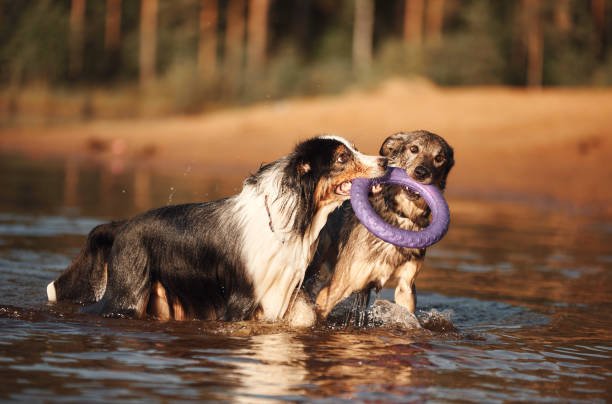
Training
Training Training Last updated July. 30, 2024 – Written by Asad Ali Hashmi Training To train an Australian Shepherd, you have to use their intelligence
Last updated July. 30, 2024 – Written by Asad Ali Hashmi
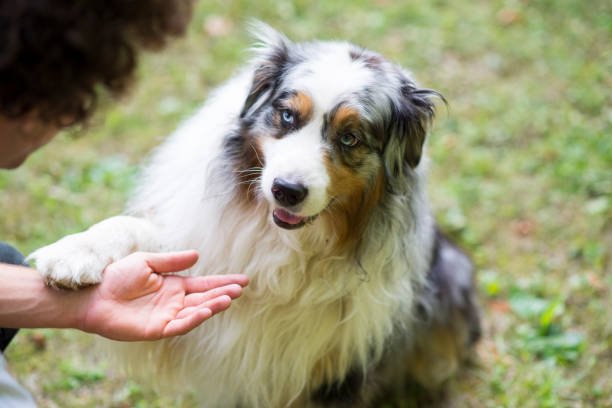
The Australian shepherd commonly called by its nickname Aussie.Aussies came into use because of their incredible herding capabilities.
Aussies were popularized for their impressive, and natural herding abilities. The Australian Shepherd is a highly intelligent working dog with a strong desire to be active. Australian Shepherd has the potential to perform a great number and variety of duties as diverse as being Guide Dogs, Hearing Dogs for the Deaf, drug detection dogs at the airport, or in search and rescue situations, makes them truly irreplaceable working companions. With their ability to do many tasks well, they have a strong work ethic and are adaptable.
Aussies are a great breed for someone who leads an active lifestyle and has some dog experience. Australian Shepherds are smart, loyal, adaptable, and great protectors. They do, however, need a great deal of exercise (be prepared for long walks and outdoor play hours), mental stimulation, as well as companionship. However, they may not be well-suited if the owner is unable to satisfy their high level of energy and training requirements.
The Australian Shepherd is a very versatile and highly intelligent breed that attracts many dog owners with its strong work ethic. Great in herding, agility, and service work roles, they are desirable for active owners too. Apart from being great family pets, their loyalty and affectionate nature make them the ideal choice. Furthermore, they are endowed with distinctive features, highlighted through their eccentric coat colors and expressive eyes. This flexibility in function is one reason why they are a popular breed with people looking for an active, trainable, companion dog.
Important Characteristics of Australian Shepherds:
Intelligence: These dogs are very intelligent and they tend to have the best memory, in addition.
Exercise: super high-energy — much exercise needed.
Some breeds bond very closely with their family and are more prone to worry or even panic when left alone by their owner.
Role: Accomplished many things including herding, agility, and also can be a therapy or service dog.
Vigilance: High natural dander and vigilant.
Life expectancy: 13 – 15 years
Australian Shepherds have a lifespan of about 13-15 years. That number can be a bit different for everyone since it depends on genetics, what you eat and how active you are as well of your overall level of health care. Their life can be prolonged and their health rejuvenated with a balanced diet and regular veterinary check-ups.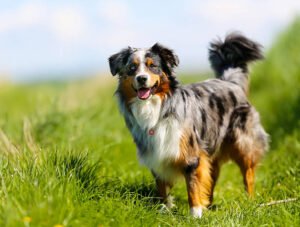
Type:
Medium length, weather-resistant double coat; straight to wavy.
Colors:
Blue merle, red merle; black & all colors with white markings and/or tan points.
Eyes:
Most commonly with piercing, eloquent eyes which can be brown, blue, hazel, amber, green, or a mix of these too (heterochromia).
Blue, brown, or amber; may be of different colors.
Size:
Males –
Males typically stand between 20-23 inches (51-58 cm) at the shoulder
Weight: Males weigh around 50-65 pounds (23-29 kg)
Females –
Females are usually 18-21 inches (46-53 cm).
Females weigh about 40-55 pounds (18-25 kg)
Coat:
Texture: Medium length, straight or moderately wavy, weatherproof.
Colors: Common colors include blue merle, red merle, black, and red, with or without white markings and tan points.
Ears:
Triangular, high-set, upright, and break or erect with ears pointing forward.
Tail:
Naturally shaped or docked to a dock of 1-2 inches.
A breed with a medium build and alert, intelligent appearance are Australian Shepherds. Some of the attributes of their looks include
Size and Build:
Males usually weigh 50 to 65 pounds and are around twenty inches tall at the shoulder.
On average, females stand about 18 in to 21 and weigh from around pounds.
With their roots as working dogs, they have a strong, muscular body.
Coat:
Their coat is quite fluffy and of medium length which can be straight or slightly wavy.
This makes the coat weather-proof—boosting their performance in different environmental conditions.
Colors:
Australian Shepherds have several color options, like blue merle, red merle, black or in the case of Ruby loud red.
They can be found in a combination of these three and also they may have white markings and/or tan (copper) points.
Eyes:
They may have brown, blue or amber eyes (or even one of each color).
Heterochromia (eyes of different color) is not a rare thing in Australian Shepherd.
Ears:
Their high set, medium-sized triangular ears generally fold forward.
Tail:
The tail is traditionally docked in Australian Shepherds, though this practice has become less common in many areas.
Of course, their tail is even longer and relatively straight.
Expression:
Their lively, eager-to-please nature gives them an intelligent and friendly expression.
In general, Australian Shepherds are well regarded for their stunning good looks along with being highly intelligent and versatile dogs thus making them a favorite choice to work or live at your home as a family pet.
Australian Shepherds are of Two Types
Regular Australian Shepherd: often in the form of 18–23 inches tall at the shoulder.
Miniature Australian Shepherd – 13 to 18 Inches High (at the Shoulder)
Smart: Fast learners; do well in obedience training and dog sports. High energy: Regular exercise needed, best with active families. Family Loyalty and Protection: Loyalty, family values, and excellent watch dogs. Temperament: Friendly with family, can be aloof or even aggressive towards strangers. Social activities and early socialization important.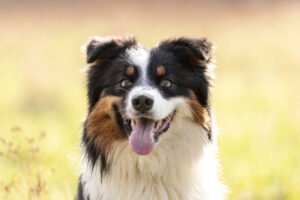
The Australian Shepherd is a very clever, energetic, and loyal dog. This breed has a strong herding background and performs exceptionally well in work that engages both their body and mind, such as agility training or obedience. They typically bond closely with their families and are protective, making them great watchdogs. They may be hesitant with strangers, but early socialization will make them friendly and well-rounded individuals. Very playful and loving which makes them awesome companions but if they get bored you better have time to take them out running or a chewy toy for when you’re not around their can become destructive.
Other Traits
Herding: Outstanding herders that have managed livestock on farms and ranches. Agility, obedience training, flyball, and frisbee: Dog Sports. Service and Therapy Work: Service, therapy dogs; can be trained.
Australian Shepherds also have the following habits to note: high energy; intelligence; herding instincts; affectionate and loyal; alert; reserved with strangers; playfulness; work ethic; need for structure; and companionship. Thus the breed needs lots of exercise, as in roaming, hiking, or fetch. Additionally, it is excellent for mental challenge, making training and puzzle time fun for both parties. Moreover, they can try and herd their owners, and they work diligently on the farm, and some excel in herding and agility. They are highly alert and may provide an excellent watchdog. However, they can also be wary of new people, making early socialization essential. They enjoy playful activities like fetch and frisbee. The breed was born to work and to please their owners. Thus, they become anxious or bored when left alone for long periods. They do well with a routine and function best when taken through boundaries.
Australian Shepherds make excellent working dogs capable of a variety of activities because they are intelligent, energetic, and versatile.
Working Group: Like most working breeds, Australian Shepherds don’t seek out human snuggles as much as they do meaningful work. On farms and ranches, they are used for handling sheep, cattle, and hogs as well as breed dogs or agility.
Speed and Agility: Good for doggie sports! They move through obstacle courses with much agility, and they are popular dogs for sporting events such as trial competitions.
Search and Rescue: Because they have an excellent sense of smell and can work very close to their handler, Australian Shepherds are used as search and rescue dogs. They can find missing individuals or sense smells in difficult conditions.
Work: They can work as service dogs helping people with disabilities or therapy dogs providing relief and emotional support in hospitals, retirement homes, schools, etc.
Search and Detection Work: Their sense of smell, along with being trainable, makes them also suitable for detection work (e.g., explosives or contraband).
Agility and Competitive Sports: Qualities such as agility participate in various dog sports like obedience, flyball; herding trials, speed, etc.
In general, Australian Shepherds are workaholics that enjoy performing a variety of duties with the mind and body.
While Australian Shepherds are typically highly trainable in obedience and manners due to their intelligence, ability to problem-solve quickly, and eagerness to please. Here are tips to ensure they remain great ambassadors for your breed:
Start From the Beginning: Training as early and often in puppyhood is key. They provide a better learning period during teaching new orders, socialization in departure area and coming well with other family pets.
Positive Reinforcement: Reward-based training is best. Treats, praise, and toys can all be used as rewards to reinforce positive behaviors and of course the great sport called learning!
Consistency is Everything: Whether it be training commands or house rules, remain consistent. To prevent any double take of your dog avoid using the same commands from everyone and rules to enforce is crucial.
Implement Boundaries: Set limits on the ways that are not right to act and provide follow-through. For example, whether your dog is or is not allowed on the furniture.
Play Obedience Training: Ensure basic obey commands like SIT, STAY, Come and Heel. Advanced obedience training is also good and helps sharpen their minds.
Socialization: Help them to be well-adjusted and reduce fearfulness or aggression by exposing them to multiple environments, people, and other animals.
Early Address of Behavioral Problems: Behavior problems should be addressed as soon as they occur. This could mean behaviors such as herding, barking endlessly, and so on. It is easier to solve a problem if intervention occurs sooner than later.
Enrichment: Keep mentally and physically active. Dogs that are exercised and have their minds kept stimulated will generally be well-behaved… the alternative leads to undesirable behaviors.
Professional Help: Use professional training if necessary, especially in more difficult behavior problems or advanced disciplines.
Routine Training: Add in a daily bit of training. Regular, short training sessions are often better than long irregular ones.
Following these practices will help to ensure that your Australian Shepherd is a well-behaved, obedient companion.
In a similar vein, Australian Shepherds are active dogs and need more physical activity to be healthy and happy. But what do Falkland Sheepdog puppies need when it comes to exercise?
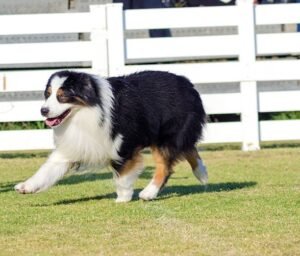
Key Workout Needs & Tips: Some of the key physical requirements are listed below and some appropriate exercises in which your puppy can participate:
Daily Exercise: You should strive for at least 1-2 hours a day. Even if this means a walk, playtime, or even some training you can cover the distance in more than one session.
Walking and Running: Walking should be regular, interspersed with more vigorous types of exercise such as jogging or running. They appreciate the room to move freely, so free running in an enclosed area is very beneficial.
Exercise: Playing games like fetch, tug-of-war, and frisbee not only keep them fit but also engage their brain. They love games that challenge them and keep their bodies moving.
Australian Shepherds + Agility: Australian Shepherds tend to do very well on agility courses, which are a good way for them to get physical and mental workouts. For instance, they love agility and any set of obstacle courses that you could build in your yard or join local agility classes.
Herding: Ideally, allowing them to engage in herding or equivalent practice is known to leave remarkable satisfaction. They love to herd and do things that replicate the work they were bred to undertake.
Mental Stimulation: Puzzle Toys — Training Exercises to Keep their Minds Active. Mental puzzles can wear them out as much as physical activity.
Socialization: Bond with other dogs and people; stay well-balanced, do extra physical exercise. Dog parks or playgroups are perfect for some socialization and exercise as well.
If not exercised enough: Australian Shepherds who do not receive enough exercise can become bored, leading to an increase in barking and chewing. Make sure to give them plenty of exercise in order for them not to get bored.
By providing them exercise with many things to do, you will help to prevent your Australian Shepherd from getting obese and keep him happy.
Australian Shepherds are very intelligent, agile dogs that do everything from herding to flyball. They do well in these key areas:
Herding: Bred for working with livestock from the beginning, they are effective herders of sheep, cattle, and other animals. Within farms and ranches, they have made themselves indispensable owing to their training from natural instincts.
Agility: Australian Shepherds are known to be great in agility, skilled at running powerful obstacle courses with high speed and excellent precision. Their quick and bright tracks make them the top athletes in agility trials.
Obedience Trials: They are up-to-point dogs, they ace in obedience training and even get commands to do with ease. Combine all that with their eagerness to please and intelligence, the reason they dominate in obedience competitions becomes obvious.
Search and Rescue (SAR) Dogs: Due to their impressive ability to track human scent as pet owners, the use of SAR dogs is high.
Flyball: Flyball is essentially a 4-dog relay race consisting of hurdles, stepping on the spring-loaded box to release a ball, and then racing back with that dropped bar for Australian Shepherds. Speed and agility are real assets in the quick of this sport.
Canine Freestyle: They appear in Canine Freestyle and their routine consists of dancing moves that are synchronized with musical accompaniment. They are easy to train and love learning new tricks, which is why they excel in this sport.
Rally Obedience: Rally obedience combines aspects of both agility and obedience, as dogs follow a course with signs that denote different commands. Their ease of responsiveness and agility are what make Australian Shepherds suited for rally.
Therapy and Service Work: Friendly papillons are great for therapy, but they can also serve as emotional support animals or lend their capabilities to a person with disabilities.
Australian Shepherds are versatile and have the drive that allows them to excel at a wide variety of work and sports, allowing us opportunities to showcase just how impressive this breed can be.
Australian-Inspired: Sydney, Boomer, Ozzy
American-Western: Ranger, Cowboy, Wyatt
Nature-Inspired: River, Storm, Rocky
Heritage Names: Basil, Luna, Blaze
The Australian Shepherd is a vigilant breed that acts as an alert watchdog. The exact traits in which they are characterized for the same can be enumerated as:
 Alertness: It helps them to monitor their surroundings closely, hence making it easy for them to detect any suspicious activity.
Alertness: It helps them to monitor their surroundings closely, hence making it easy for them to detect any suspicious activity.
Watchful: One must remember that they are very watchful and can become territorial. They will bark to warn their owners if they notice any suspicious activities or strange events.
Socialization: Early socialization is necessary to acclimate them to the world so they grow into a well-balanced dog able to differentiate between benign and threatening individuals.
Training: Though they are born with a natural instinct to protect, it is still crucial for training purposes so that your dog responds correctly and does not grow too territorial or aggressive.
While they are proven watchdogs in Australia because of their alertness and protection instincts, training helps them use these attributes properly.
One of the most intelligent, versatile, and energetic breeds you will ever meet: The Australian Shepherd. They are working dogs that do well in herding and dog sports, as companions for families. He is much loved the world over, cherished for his amiable fraternal and striking appearance.

Training Training Last updated July. 30, 2024 – Written by Asad Ali Hashmi Training To train an Australian Shepherd, you have to use their intelligence

Health and Care Health and Care Last updated July. 30, 2024 – Written by Asad Ali Hashmi Health and Care Exercise Requirements: Very high; lots
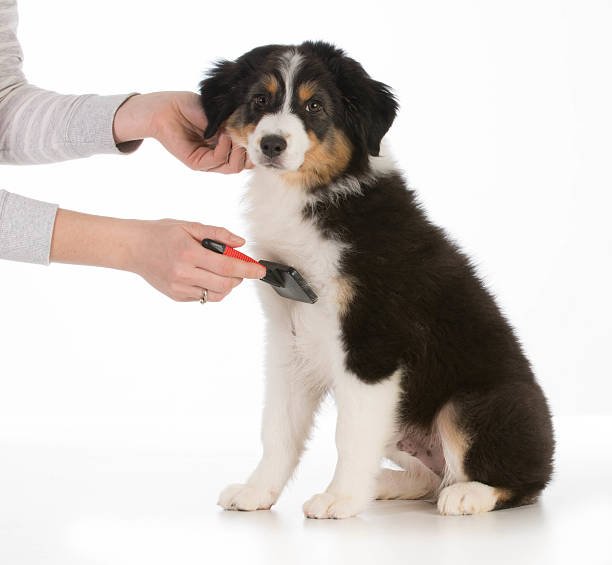
Grooming Grooming Last updated July. 30, 2024 – Written by Asad Ali Hashmi Grooming Solid doodle types will only need a brush once per week,
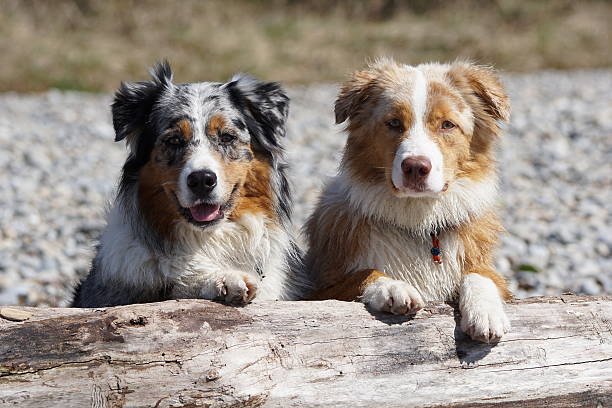
History History Last updated July. 30, 2024 – Written by Asad Ali Hashmi History Australian Shephered is a breed of livestock dog that was developed

Australian Shepherd Australian Shepherd Last updated July. 30, 2024 – Written by Asad Ali Hashmi Introduction & Overview The Australian shepherd commonly called by its